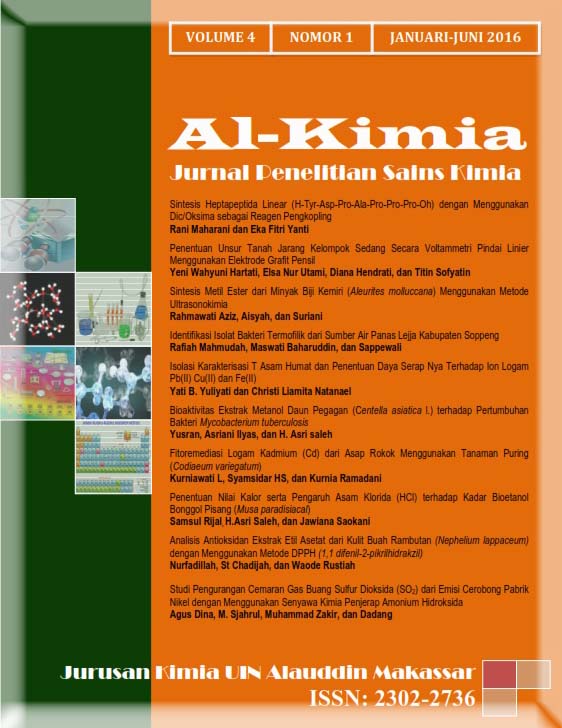Bioaktivitas Ekstrak Metanol Daun Pegagan (Centella Asiatica L.) Terhadap Pertumbuhan Bakteri Mycobacterium Tuberculosis
Abstrak
Plants gotu kola (Centella Asiatica L .Urban) is a wild plant that efficacious as remedies traditional cure disease tuberculosis (TB).TB is disease contagious infection caused by bacteria mycobacterium tuberculosis. Research aims to understand the ability extract methanol leaves gotu kola red and leaves gotu kola green and determines the concentration optimal extract methanol leaves gotu kola red and leaves gotu kola green and to know the comparison between extract methanol leaves gotu kola red with an extract methanol leaves gotu kola green in inhibits the activity of mycobacterium tuberculosis.Extraction done with the methods maceration use methanol and continued with evaporation until obtained extract viscous .Testing antibacterial activity done in a microscopic observation drug susceptibility ( mods ) use plate petri dish 24 hole with the variation of concentration ie 20%,40%, 60%, 80% and 100%.The results of testing show that extracts methanol leaves gotu kola red and leaves gotu kola green positive capable of inhibiting the growth of bacteria mycobacterium tuberculosis with inhibition optimal in concentration 80 % and 100 % characterized by the absence of growth bacteria colonies which are (-) or 0 %.Extract methanol leaves gotu kola green capable of inhibiting the growth of bacteria mycobacterium tuberculosis better than extract methanol leaves gotu kola red seen in concentration 40% and 60%.
##plugins.generic.usageStats.downloads##
Referensi
Abd Gafur, Maryati.“Isolasi Dan Identifikasi Senyawa Flavonoid dari Daun Jamblang (Syzygium Cumini)”.vol. 1, no. 1 (2010), h. 1.
Ahmad, Ahyar dan Muh. Nasrum Massi.The Antituberculosis Drug Rifampicin is Activated By 2’, 5’-Dimethyl Benzopelargonolactone from The Leaf of Coleus Atropurpureus L. Benth. International Journal of Pharma and Bio Sciences. Vol. 5, no. 1 (2014), h. 4.
Angria, Milsa.“Pembuatan Minuman Instan Pegagan (Centella Asiatica) dengan Citarasa Cassia Vera”. Skripsi. Padang: Fakultas Teknologi Pertanian Universitas Andalas, 2011.
Anita, at.al. “Evaluation of the Microscopic-Observation Drug-Susceptibility Assay Drugs Concentration for Detection of Multidrug-Resistant Tuberculosis”. vol. 08, no. 05 (2014): h. 257.
B, Devi Hidayati, Mutia dan Taslim Ersan.“Kajian Antituberkulosis pada Ekstrak N-heksan Mundu Alas (Mammea Odorata Raf)”. (2012): h. 1.
Girsang, Merryani.“Mycobacterium Penyebab Penyakit Tuberculosis Serta Mengenal Sifat-sifat Pertumbuhannya di Laboratorium”. Pusat Biomedis dan Teknologi Dasar Kesehatan Badan Litbang Kesehatan Jakarta (2013): h. 1.
Kumar, Vinay, dkk, “Effect of Centella asiatica against anti tuberculosis drugs-induced hepatotoxicity: Involvement of mitochondria and oxidative stress”, vol. 3, no. 5 (2014), h. 310-311.
Mora, Enda dan Armon Fernando.“Optimasi Ekstraksi Triterpenoid Total Pegagan (Centella asiatica (Linn.) Urban) yang Tumbuh di Riau”. vol. 1, no. 1 (2012): h.1.
Musyarofah, Neni, dkk.“Respon Tanaman Pegagan (Centella asiatica L.Urban) Terhadap Pemberian Pupuk Alami di Bawah Naungan”. vol. 35, no. 3 (2007): h. 1.
##submission.copyrightStatement##
##submission.license.cc.by-nc-sa4.footer##Authors who publish with this journal agree to the following terms:
1) Authors retain copyright and grant the journal right of first publication with the work simultaneously licensed under a Creative Commons Attribution License that allows others to share the work with an acknowledgement of the work's authorship and initial publication in this journal.
2) Authors are able to enter into separate, additional contractual arrangements for the non-exclusive distribution of the journal's published version of the work (e.g., post it to an institutional repository or publish it in a book), with an acknowledgement of its initial publication in this journal.
3)Authors are permitted and encouraged to post their work online (e.g., in institutional repositories or on their website) prior to and during the submission process, as it can lead to productive exchanges, as well as earlier and greater citation of published work (See The Effect of Open Access).


